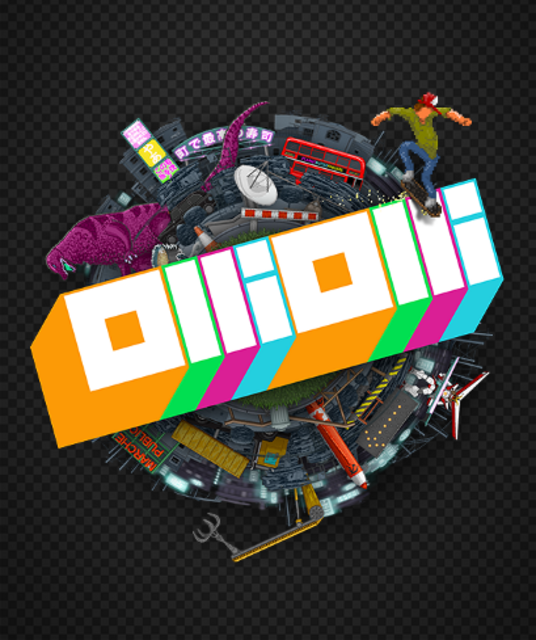Skate or Die
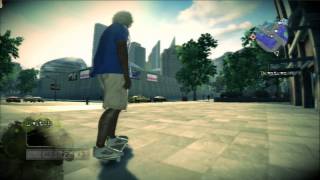
The original OlliOlli is an interesting game, largely because of how it was reacting to the environment it was released into. Any skateboarding video game brought out since 2007 is presenting itself in the wake of Skate, a game that was to a large extent a reaction to the other big player on the scene, Tony Hawk. Tony Hawk was about being able to quickly and easily flick from one trick to the next, bringing both the thrill of chaining together inhumanly long strings of grinds and aerial gymnastics, and the challenge of seeing how big a score you could rack up without breaking your combo. Skate replied to that with a game that eschewed the idea of each button and stick controlling the overall movements and actions of a character, as we see in most games, and instead aimed to tie the body parts of the skater more closely to the parts of the controller, implementing a philosophy on character control not far from what QWOP ended up with, but in service of a totally different feel. Skate doesn’t want you to just be able to perform a trick, it wants you to get a tactile sense of what it’s like to perform that trick, and it wants you to meet a level of technical proficiency to do so. Skate’s idea of achievement isn’t as much getting a lengthy sequence of effortlessly executed tricks, but tackling the inputs and timing required to perform tricks at a basic level in the first place.
Given that Tony Hawk and Skate are the two defining works of the genre, anybody making a skateboarding game today must decide how much their game is going to be a Tony Hawk and how much it is going to be a Skate, or to put it another way, they must decide to what extent it is about making players feel like a badass right out of the gate and to what extent it is concerned with mastery of mechanics and a realism in the way tricks are performed. Even more importantly, when we already have a more gamey skateboarding game and a more technical skateboarding game, newcomers to the genre have to think very carefully about what they can bring to the table that nobody has before. That’s certainly what Roll7 did with their 2014 title OlliOlli, a game that’s one part Tony Hawk, one part Skate, and one part ideas generally unassociated with this branch of video games.
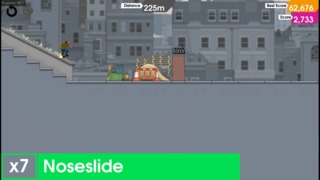
The launching platform which allows OlliOlli to set itself so squarely apart from the big two is its 2D side-on perspective. In fact, in many ways the game takes just as much from the platforming genre as it does from skateboarding games and could be fairly accurately framed as a platformer. You move from left to right across each stage, jumping hazards and grinding rails to try and get to the goal, and if you make it to the end you unlock the next stage along. Every stage has five different unique challenges to complete and high scores are a big part of play, but the most basic objective the game gives you is the same objective that Super Mario gives you: Jump the hazards until you get to the other side of the level. Even when you’re going after those high scores and extra challenges OlliOlli requires you to correctly time your jumps and other actions the same way a platformer often does, and the tricks that might otherwise be simple score bait serve this purpose as well. Execute a grind or a landing perfectly and you’ll get a speed boost, fail to do so and you can find yourself slowing down, sometimes eventually losing the momentum to get the air you need, or just stopping entirely and falling off your board. You can use the A button to push against the ground and gain some speed, but only in an open spot in the level. The rest of the time it’s all down to your skill.
Execution of moves is really the “Skate” part of this game. If you want to ollie you need to flick the left stick downwards and then release, or if you want to perform a more complex aerial move you’ll need to swivel the stick around in various quarter-circle and half-circle patterns. Grinds consist of pushing the left stick in one of four directions before hitting a grindable edge, and you can also use the bumpers to augment any trick in various ways, but the latter is not usually something that’s compulsory to think about. Where this gets a bit Tony Hawk is that the levels are set up in such a way that to get through the slalom of obstacles you can or must chain long series of moves together. It’s common to find yourself jumping through combos of 10 or more tricks at a time, and making landings and jumps within a fraction of a second of each other. It’s through this aspect of the game that you feel the 2D perspective focus the experience. While 3D forays into the world of skateboarding can more accurately emulate the feel of rolling your board around an open space and allow you the freedom of using an open level to perform tricks on your own terms, OlliOlli’s side-on perspective allows you to more clearly see upcoming parts of the level, but only up to a hard point, and has the game decide what obstacles you face in what configuration and order. It lets it make its levels a tightly-paced but fair flurry of high-speed platforming and trick taking where you’re constantly reacting to previously unseen obstacles. It’s an exhilarating experience.
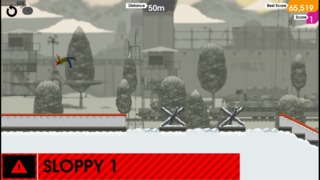
Jumps and combos are however only two parts of OlliOlli’s three part equation, as one of the skills the game constantly demands from you is timing, probably even more so than Skate. Those perfect grinds I mentioned earlier can only be performed by pushing the stick in the relevant direction a split-second before you start your grind, while perfect landings are sealed by hitting the A button a split-second before you reconnect with the ground. In fact, the amount of points you bank from a combo is hugely dependent on how well you land. The closer to the ground you hit “A”, the larger the score you pick up, but fail to hit it before your wheels are back on the dirt and you’ll be thrown a trivial numbers of points and temporarily lose control of your board. Later levels put hazards immediately after landing areas to make any sloppy landing an instant fail. OlliOlli is the kind of game that says it won’t reward you for pulling off a bunch of fancy tricks unless you have first mastered your fundamentals, but when you hear that “Whoosh” and lay your eyes on the green “Perfect Landing” banner, you’re reassured you’ve done well. This same attitude can be seen in how the game treats falling off your board.
There are other games where it’s easy to slip up and put yourself in a faceplant, but you get right back up and keep on going. Falling off in OlliOlli means having to start the level over. It doesn't simulate the lingering nature of the pain that you get from actually falling off a skateboard, but you have to recover and start anew, and that helps emulate that spirit of perseverance you need to get good in real skateboarding. As in any punishing game you are pushed to get a hold of and keep a tight grip on the basics, because even when you’ve been playing for a long time it’s easy to fall down a flight of stairs or collide with a dumpster if you’re not properly paying attention to what you’re doing. As in the actual sport even the experienced sometimes make simple mistakes. That higher expectation the game places on you also makes you train yourself to a place where you can get a smoother and more exciting flow between your jumps and grinds.
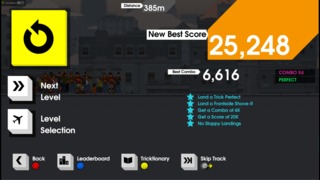
If there’s a serious weakness in OlliOlli it’s not in the actual content but in how it serves up that content. The levels you successively unlock as you go are the “Amateur” levels, but with a powerful display of skill you can also be granted access to the game’s “Pro” levels. Each of the game’s stages has a number of objectives like “Score 240,000 points”, “Perform a 360 hardspin”, or “Collect all the spray cans” and upon completing one you’re awarded a star for that level. Collecting all five stars on a single level unlocks its Pro counterpart and if you are the right combination of insane and driven you can five star all the Pro levels to unlock the even harder “Rad Mode”. It should be noted that even the Amateur levels get pretty brutal, but if you’re hoping to play this game in a way that involves less than total dedication, you may be a little disappointed.
You see, after much trying and retrying I finally completed the last level of the last world on Amateur and there was no “Congratulations”, no credit sequence, not even an achievement unlocked, I was just thrust back out to the menu. The intent is clear, it’s part of OlliOlli’s pervading idea that the goal is not simply to play through the game but to master it. However, design choices like this raise the question “If OlliOlli is that concerned with the mastery of its mechanics, why make an easier set of levels at all?”. The problem here is not that the game is difficult, but that it provides a more accessible side it can’t fully commit to. A large part of that problem manifests as a vast, empty gulf of reward between completing a level on Amateur and unlocking the Pro version of it. The stars don’t mean anything unless you have all of them in a level and it’s not like levels are built in such a way that you might see yourself making a little more progress and then a little more progress as clearly as you would in a Super Meat Boy. And this gap is only so much larger when it comes from taking the leap from playing the Pro levels to unlocking the Rad Mode. Even in many of gaming’s most challenging recent releases, there’s been at least some understanding of the importance of periodic reward, some way in which the game either implicitly or explicitly throws you a bone or reminds you you’re getting somewhere when you do well, but that feels frequently absent here, and the idea of the Amateur path feels somewhat deceptive.
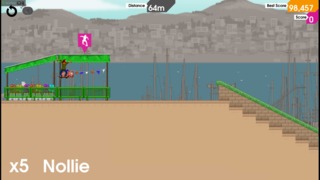
The intensity of the gameplay is however nicely offset by the graphics and sound. The game’s low detail art and generally relaxed soundtrack add enough style to the game without hoarding in on the space rightfully served for the gameplay. The aesthetic elements hang back a little while the mechanics do the talking. There’s also a nice range across its environments as it shifts from humble city streets to sinister Russian military bases, and the music is equally as eclectic. With the amount of time you’re likely to spend in the game it could honestly do with having more than the ten or so tracks it has, but the creators have a knack for featuring music that spans a range of genres and styles, and yet has a remarkable consistency. Some of its loud, a lot is more quiet, there’s trip-hop, there’s rock, but it all works. Listening to it I felt like I was standing on the side of a lazy New York street, watching the world go by.
Overall, OlliOlli is not a skateboarding playground in the same way that Tony Hawk or even Skate was, but if you want a game that combines both invigorating speed and a fair-handed test of your skills, look no further. Just be aware that now and then OlliOlli can start to forget about you as a player.
